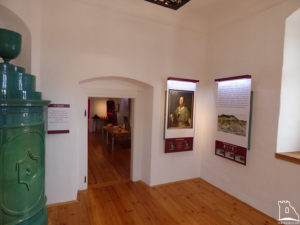Szászvár

Szászvár is located in Hungary and its name first appears in written sources in the first half of the 13th century. The papal tithe register of 1334 mentions the parish priest of the village, Ivan. In 1347 the village is mentioned in the charter of the Pécs Chapter. In 1401 the village is mentioned as a market place “Forum comprovinc. in poss. seu villa Zaz”. In 1439 it is mentioned in a document as ‘Zaaz’.

The castle of Szászvár was built as a bishop’s residence in the second half of the 14th century. Cardinal Bálint Alsáni, bishop of Pécs, originally had a chapel and a manor house built on the outskirts of the settlement. The yard house was a stone building with a cellar, two floors and two rooms per floor, the entrance was in a staircase tower.

It is one of the earliest surviving examples of the medieval courtyard house type that spread throughout Europe in the 15th and 17th centuries. A document from the time of King Sigismund records that Pope Gregory XII granted a year and 40 days of penance to all those who, after repenting and confessing their sins, visited the chapel founded by Cardinal Bálint and others in honor of the same saint in the diocese of Pécs, the “Zaas Oppidum”, on the day of St. John the Baptist’s birth.

It was first mentioned as a castle on May 28, 1439, when King Albert ordered Tolna County to investigate the complaint of László Töttős of Bátmonostor against the damage caused by the members of the family of Bishop Henrik of Albeni staying in the castle. In 1476, Bishop Zsigmond of Pécs entrusted the castle and the parish of Sász to Nagylucsei Orbán, the provost of the St. Nicholas co-chaplaincy of Székesfehérvár. Nagylucsei later became the treasurer of King Matthias.

In 1540, on the orders of Queen Isabella, Athinai Simon conquered Szászvár Castle, which briefly became the property of the queen. In 1542, Imre Werbőczy, with 225 horsemen and 200 infantry, set out from Szászvár and ambushed the troops of the Bey Kászon on the field of Kosar. This was also sung by Tinódi Lantos Sebestyén.

Pécs fell on July 13, 1543, and on the same day, Szász surrendered to Ahmed Pasha. The importance of the settlement and its strategic position is shown by the fact that the Turks made it an administrative center and the seat of a Nahije. According to a document from 1554, 188 villages belonged to it, and this document refers to it as the “town” of Szász with 37 tax-paying houses. The number of Turkish guards is known only until 1546 when a garrison of almost 250 men guarded the northern part of Pécs. This number decreased when the castles of Tolna also fell into Turkish hands.

The devastation of the Fifteen Years’ War did not spare Szászvár, and in 1603 the Christian armies burned the castle. In 1662 it was burnt down by the infantrymen of Kiskomárom, and during the winter campaign of Zrínyi Miklós in 1664 a part of the Hungarian troops occupied the settlement and burnt down the castle again. Around 1680 the Christian troops blew up the fortress, but the Turks probably did not abandon it. The settlement and the castle were finally liberated from the Turkish occupation in 1686 when the imperial troops took possession of the settlement and the castle. Szász was destroyed during the fighting, and a document from 1696 refers to it only as a village

In 1772, Bishop Klimó György started the construction of a new church on the site of the ruined castle, which was completed in 1779. In 1822 a tower was added to the church using the castle walls, but it collapsed in 1890 and was demolished and replaced by the present tower. It is interesting to note that Martinovics Ignác was awarded the title of “Abbot of Szászvár” in 1792 for his “services”. He was later beheaded as a Jacobin conspirator in Buda.

Archaeological research on the castle started in the early 1980s, led by archaeologists Dr. Sándor Mária and Dr. Gerő Győző.In 2015-2016 the castle was restored as a historical monument.
Source: Várlexikon https://varlexikon.hu/szaszvar

Dear Readers, I can only make this content available through small donations or by selling my books or T-shirts:
Please, feel free to support me with a coffee here:
You can check out my books on Amazon or Draft2Digital, they are available in hardcover, paperback, or ebook:
https://www.amazon.com/dp/198020490X or at https://books2read.com/b/boYd81

My work can also be followed and supported on Patreon: Become a Patron!http://Become a Patron!
[wpedon id=”9140″]

https://hungarianottomanwars.myspreadshop.com/all
































